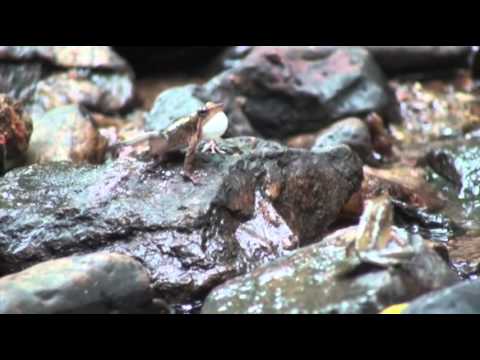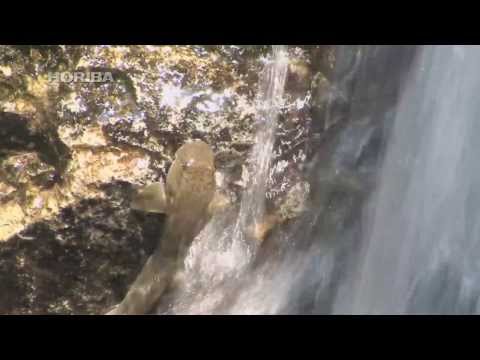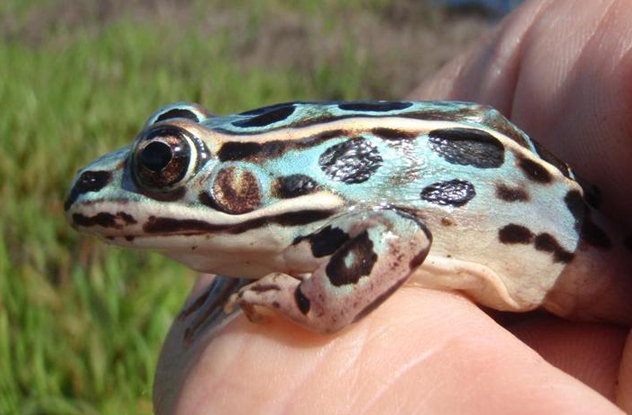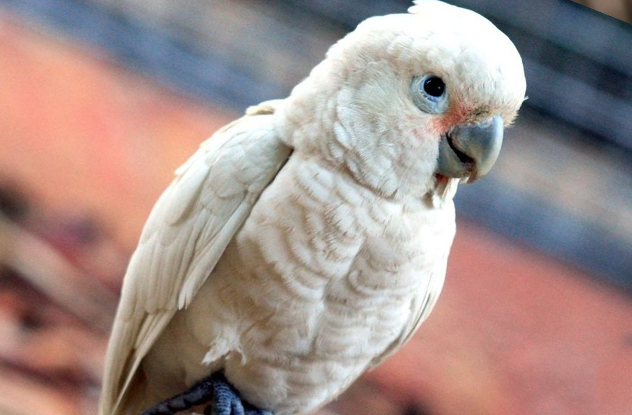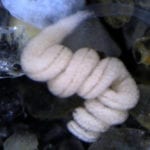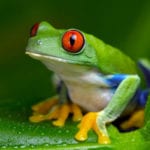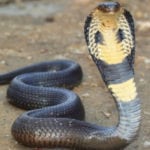10The Great Bustard
We’ve already talked about bustards, which look like small ostriches, and the way the males puff out their throats to the size of an American football and dance around to attract their mates. But a new study published in PLOS ONE suggests that females aren’t attracted to the male’s puffed feathers in the front. Instead, the female is actually checking out the male’s caboose. The researchers believe that the female is looking at the male’s cloaca, a hole surrounded by white feathers that’s used for intestinal, urinary, and reproductive purposes. Supposedly, she’s checking for evidence of bacteria-induced diarrhea to see if she’ll get a sexually transmitted disease. This kind of bird sex is known as the “cloacal kiss,” in which the female repeatedly pecks at the male’s cloaca. But there’s even more to this theory. To sell the female on his sex appeal, the male great bustard supposedly eats poisonous blister beetles to appear more healthy by clearing his system of parasites that can cause diarrhea. If the beetle toxin (cantharidin, long mistaken as an aphrodisiac in humans) doesn’t kill the bird’s parasites, it usually convinces them to find a new host. The great bustard usually eats no more than three beetles at a time. Otherwise, the bird may poison itself and die. Of course, even though the bustards’ behavior is unusual, these researchers can’t really be sure what the birds are thinking. According to Daphne Fairbairn, an evolutionary biologist not involved in the study, “What they’re suggesting is a really cool idea, but that’s all it is at this point. As they acknowledge in the article, they really can’t show a connection between mating success and this behavior in males.”
9The 750-Leg Millipede
No millipede actually has 1,000 legs. Most only have 80–100. But despite being only about 2.5 centimeters (1 in) long, these white millipedes have up to 750 legs for the females and 562 for the males. They look like threads. But when scientists put them under powerful microscopes, an “amazingly complex anatomy” was revealed. For now, the Illacme plenipes millipede holds the record for being the world’s leggiest creature. Illacme plenipes has no eyes, but its huge antennae help it probe the darkness. It also has a rudimentary fused mouth that pierces and sucks plants for food. The hairs on this millipede’s back produce silk, which may clean bacteria off its body. Scientists believe the millipede’s abundant legs help it tunnel underground or cling to sandstone boulders in its foggy northern California habitat near San Francisco. Until a team of scientists observed them in 2006, these millipedes were last seen in 1928. They’re so rare that they were previously thought to be extinct. Their nearest relatives live in South Africa. Scientists believe these millipedes may have lived on the supercontinent, Pangea, before its landmass broke apart over 200 million years ago into the separate regions of California and South Africa.
8The Dancing Frogs
In the Western Ghats jungle mountain range in southern India, scientists have discovered 14 new species of dancing frogs, each of which are about the size of a walnut. That brings the number of these species, which are found only in the Western Ghats, to 24. But climate change is wreaking havoc with these tiny frogs’ habitat, and they may soon be extinct. “Back in 2006, we saw maybe 400 to 500 hopping around during the egg-laying season,” says University of Delhi professor Sathyabhama Das Biju. “But each year, there were less, and in the end, even if you worked hard, it was difficult to catch even 100.” The frogs can only mate during a brief period between monsoon season, when storms would sweep them away, and the dry season, when streams dry up completely. When these delicate frogs mate, only the males dance in an effort to impress the females. There’s a 100-to-1 male-to-female ratio, so the males have to compete for the attention of the ladies. The larger the male frog, the more it dances. The males extend and whip their legs to the side to get the attention of females that might not hear them over the sound of the streams. The males also literally kick away their competition with their dance moves to have a better chance of mating.
7The Nopili Rock-Climbing Goby
The Nopili rock-climbing goby is perfectly attuned to its rugged environment. These 2.5-centimeter (1 in) fish live in Nanue Falls on the Hamakua Coast in Hawaii. Storms and other natural phenomena often disturb the goby’s freshwater habitat. So it uses its mouth and belly suckers to climb steep waterfall cliffs as high as 30 meters (100 ft) to return to its starting point upstream. For the goby, it’s like running a marathon. Watch this video on YouTube Scientists were fascinated by this behavior but couldn’t figure out what was going on. So they decided to catch some of these fish to study them. But these cunning fish would watch as a biologist struggled in the strong current to get close to them, and then the fish would dart away. As Richard Blob, an evolutionary biologist from Clemson University, said, “You don’t want to attach too much personality to these animals, but they almost had a mocking expression.” Eventually, the biologists caught the fish they needed. In a lab in Hawaii, these fish would first feed on algae-covered glass and then climb the glass when a waterfall was simulated. Blob and his team found that the front part of the goby’s upper jaw protruded the same way whether it was eating or climbing. From an evolutionary standpoint, that means the Napoli rock-climbing goby probably exapted, or co-opted, one of these behaviors and adapted it to do the other, completely different behavior. But Blob can’t tell whether eating or rock climbing developed this way first.
6The Koala
The koala has a unique, sound-producing organ outside of the larynx (also known as the “voice box”) that it uses to produce mating calls. So far, researchers have never seen this in a land-dwelling mammal. The calls are 20 times lower than usual for an animal of its small size and sound like something you’d expect from an elephant. “We have discovered that koalas possess an extra pair of vocal folds that are located outside the larynx, where the oral and nasal cavities connect,” explains Benjamin Charlton of the University of Sussex. “We also demonstrated that koalas use these additional vocal folds to produce their extremely low-pitched mating calls.” The koala’s mating calls consist of a continuous set of sounds made while inhaling and exhaling. When inhaling, the koala sounds like it’s snoring loudly. When exhaling, it sounds like it’s belching loudly. Supposedly, this combination of loud snoring and belching attracts female koalas, even though it often has the opposite effect between human males and females.
5The White-Footed Sportive Lemur
White-footed sportive lemurs dwell in trees in southern Madagascar. Technically, families of parents and children live together, but these nocturnal creatures tend to physically avoid one another. Parents don’t sleep in the same tree or search for food together. Instead, family members keep tabs on one another by urinating and defecating at a common latrine, which is a group of trees located in the middle of their territory. After observing 14 adult sportive lemurs for over 1,000 hours, researchers from the German Primate Center (DPZ) concluded that family members leave urine scent signals on tree trunks as messages to each other. In a way, it’s like humans scribbling messages on a bathroom wall. “The chemical traces in the urine are unique for each lemur, so by leaving scent marks, the lemurs can interact and bond with their family without meeting them,” says Iris Droscher of the DPZ. “Scent marks [also] inform an intruder that there is a resident male that is willing and able to defend his partner.”
4The Blue Leopard Frog And The Blue Lobster
Leopard frogs almost always have green or beige coloring. But late in the summer of 2014, conservation scientist Jacob Kukel found a bright blue leopard frog in Massachusetts. “This colorful little frog . . . looked like it belonged in the tropics,” he said. As far as Kubel knows, only three more blue leopard frogs have been discovered in the United States, one in New Jersey in 2003, one in Delaware in 2007, and one in New York in 2014. According to Kugel, the standard green and beige coloring of leopard frogs comes mostly from the yellow pigment in their skin cells. If the yellow pigment cells are absent or in the wrong part of the frog’s body, then a blue frog is the result. Also late that summer, a teen and her father found a rare blue lobster in one of their lobster traps near Portland, Maine. They donated the lobster, named “Skylar,” to the Maine State Aquarium. This blue color occurs in one of every two million lobsters. It’s caused by a genetic defect that makes the lobster produce too much of a certain protein. The rarest type of lobster is known as an albino or crystal lobster. With absolutely no color in its shell, a crystal lobster occurs in one of every 100 million lobsters.
3The Superb Fairy Wren
In 2013, the superb fairy wren was voted Australia’s favorite bird in a national poll. This pretty bird is only about 14 centimeters (5.5 in) long with the male having bright blue feathers. Superb fairy wrens are called the “least faithful birds in the world” because females may have as many as 13 male suitors in a 30-minute period. But scientists also find these tiny songbirds to be curious creatures because they’re able to recognize voices in the womb. This skill allows the mother wren to teach a special tune to the embryos before they hatch. That tune will then be used as a password between mother and chicks. When the babies hatch, their begging calls include this password tune so the mother knows it’s not feeding Horsfield’s bronze-cuckoo chicks, which bronze-cuckoo mothers often deposit into other nests to get out of feeding their own chicks. If a baby bird doesn’t know the password, the fairy wren mother won’t feed it. In fact, the superb fairy wren mother may abandon the nest and start a new family elsewhere.
2The Goffin’s Cockatoo
We’ve talked elsewhere about the way cockatoos have escaped from their human owners into the forests of Australia and taught wild birds to talk—even using expletives in some cases. But Goffin’s cockatoos, which are a type of Indonesian parrot, have now outdone this. In 2012, a captive Goffin’s cockatoo named Figaro discovered how to make tools out of branches and its wooden aviary beams to rake in nuts and a pebble it used as a toy. Then, in an experiment in 2014, Figaro taught other cockatoos how to make tools in what is believed to be the first time any birds have been able to learn this way in a controlled experiment. The first cockatoo group watched Figaro make wooden tools to rake in nuts. The second cockatoo group saw “ghost demonstrations,” with either the tools or the nuts moving by themselves using magnets. All the males, but none of the females, in the first group (that watched Figaro) learned to make tools and use them to rake in nuts. None of the males or the females in the second ghost demo group were able to make tools. But the most amazing thing was that the cockatoos learned to make tools better than Figaro. So they didn’t just imitate his behavior; they surpassed it.
1The Sea Slug
A particular type of sea slug (also known as a nudibranch) severs its own penis after mating and regrows a new one within a day so it can do the deed again. In a process called autotomy, some sea slugs will sever body parts like the “frilly skirt” surrounding its body if it wants to distract and escape a predator. But so far, only the species Goniobranchus reticulata does it to its penis. Almost all nudibranchs have both male and female sex organs. That means each sea slug can deposit and accept sperm simultaneously. They also store sperm from different sex partners at the same time, which means a sea slug can decide which sperm to use to fertilize its eggs. It digests the leftovers. The colorful G. reticulata lives in shallow coral reefs in the East China Sea. These sea slugs cut off their penises only after they disengage from their partners. Researchers found sperm caught in the spines covering the discarded penises. So these scientists believe that the sea slug severs its penis so its partner will be more likely to fertilize its eggs with that sea slug’s sperm. “If the sea slug left the penis in the mating partner’s female organ, it could not remove sperm of preceding mates,” explains Ayami Sekizawa, a researcher from Osaka City University in Japan.


